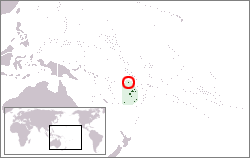
Rotuma is a self-governing heptarchy, generally designated a dependency of Fiji. 'Rotuma' commonly refers to Rotuma Island, the only permanently inhabited and by far the largest of all the islands in the Rotuma Group. Officially, the Rotuma Act declares that Rotuma consists of Rotuma Island as well as its neighbouring islands, rocks, and reefs across the entire Rotuma Group. The dependency is situated around 500 km west of the French islands of Wallis and Futuna and a similar distance north of the Fijian mainland. Its capital is Ahau, a hamlet consisting of a number of colonial-era buildings. Rotuma exists as a dependency of Fiji but itself contains its own socioreligious pene-enclave known traditionally as Faguta where the chiefs and their villages adhere to the practices of worship, festival dates, and French-based writing system of the Marists. Faguta's special character was effectively agreed to by all Rotuma's chiefs in 1871 in the Treaty of Hamelin.
Rotuman, also referred to as Rotunan, Rutuman or Fäeag Rotuạm, is an Austronesian language spoken by the Indigenous people Rotuma in South Pacific. Linguistically, as well as culturally, Rotuma has had Polynesian-influence culture and incorporated as a dependency into the Colony of Fiji in 1881. The contemporary Rotuman language resulted following Samoan and Tongan incursions into Rotuma, which was initially inhabited by Tahitians.
Solkope is a small and densely wooded island off the southern coast of Rotuma in the Fiji Islands, at the edge of the fringing coral reef. It is separated from the main island of Rotuma by a channel that is between 50 and 200 m wide, and lies immediately southeast of the village of Kalvaka in the district of Noaʻtau. It 765 m long east–west, and up to 515 m wide, and rises to a height of 128 m. Its area is 0.3 km2. From the sea, it cannot be recognised as a separate island.
Gagaja is a Rotuman word denoting the position of "Chief" or "Lord". This could be a formal chiefly position in one of the seven districts or a village chief as well as to anyone else, such as the Chairman of the Rotuma Island Council to whom respect and deference is owed based on their own skills and attributes. Unlike in many other Pacific cultures, the official chiefly positions are not allocated according to any strict primogeniture, but rather are elected from all eligible males within certain kạinaga to whom the chiefly title belongs.
The Rotumans are a Polynesian ethnic group native to Rotuma, an island group forming part of Fiji. The island itself is a cultural melting pot at the crossroads of the Micronesian, Melanesian and Polynesian divisions of the Pacific Ocean, and due to the seafaring nature of traditional Pacific cultures, the indigenous Rotuman have adopted or share many aspects of its multifaceted culture with its Melanesian, Micronesian and Polynesian neighbours.

Fiji has three official languages under the 1997 constitution : English, Fijian and Fiji Hindi. The Fijian language is spoken as the first language by most indigenous Fijians who make up around 54% of the population.
The Land Has Eyes is a 2004 Rotuman film written and directed by Vilsoni Hereniko. It is the first ever feature film from Rotuma.
Vilsoni Hereniko is a Rotuman playwright, film director and academic. He was the writer and director of Rotuma's first ever feature film, The Land Has Eyes.

Decalobanthus peltatus is a species of flowering vine in the morning glory family, Convolvulaceae, that is native to Pemba Island, the Mascarene Islands, Madagascar, the Seychelles, Indonesia, Malaysia, the Philippines, northern Queensland (Australia) and French Polynesia. It has been introduced and subsequently become invasive on some of the other Pacific islands, such as New Caledonia, Samoa, Fiji, Solomon Islands, and Palau.

Uea is a high rocky offshore island of Rotuma. Uea is one of a number of outliers lying off the west coast of Rotuma. It is the second largest island and is the highest island in the Rotuma Group with an elevation of 260 metres (850 ft).
Simba is a small village along the Mombasa Road (A109), some 140 kilometers southeast of Nairobi, between Emali and Kiboko. It is situated on the boundary of the Makueni and Kajiado counties. The Simba Plains are located some 10 kilometers due south.
Intercourse Island is an uninhabited island in the Dampier Archipelago, in the Pilbara region of Western Australia.

Pee Pee Island is a small island located in the province of Newfoundland and Labrador in the far east of Canada. It is the smallest of the four islands in the Witless Bay Ecological Reserve, which it became a part of in 1983. It serves as a breeding place for Atlantic puffins.
Ilemba Island is an island in Lake Victoria. Administratively it belongs to Kenya. It is part of the Homa Bay County, in the western part of the country, 300 km west of the capital Nairobi.
Mageta Island is an island in Kenya on Lake Victoria.
Kiringiti Island is the name given to an island in Lake Victoria. Administratively, it belongs to Kenya. It is part of the Homa Bay County, in the western part of the country, 300 km west of the capital Nairobi.
Sumba Island is an island in Lake Victoria that is divided between Kenya and Uganda. It is located in the administrative area of Busia County in the western part of the country, 400 km west of the capital Nairobi.

Plagia is a village in the Kilkis region of Greece. It is situated in the municipal unit of Cherso, in the Kilkis municipality, within the Kilkis region of Central Macedonia.
Rotuman New Zealanders are Rotuman immigrants in New Zealand, typically from Rotuma Island or Fiji, their descendants, and New Zealanders of Rotuman ethnic descent. At the time of the 2018 New Zealand census, 981 people in New Zealand were surveyed as being of Rotuman descent.
Aanikai is the main island of North Tabiteuea, in Kiribati.







